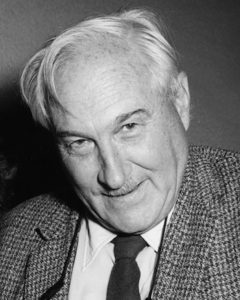
Louis Leakey
*Louis Leakey was born on this date in 1903. He was a white-African anthropologist and historian.
Born at Kabete Mission, near Nairobi, Kenya, Louis Seymour Bazett Leakey's parents, Harry and Mary Leakey, were English missionaries to the Kikuyu tribe. Despite brief stays in England during childhood, Louis grew up more African than English. He played with Black Africans, learned to hunt, spoke Kikuyu as fluently as English, and was initiated as a member of the Kikuyu tribe.
At 13, after discovering stone tools, he became passionate about prehistory and decided to learn about the people who made them. In 1922, he started his studies at Cambridge; in 1926, he graduated with degrees in anthropology and archaeology. In 1928, Leakey married Frida Avern, an Englishwoman he had met in Africa. Over the next few years, he conducted several excavations in East Africa. In 1930, Leakey was awarded a PhD. for his work. In 1932, he discovered fossils at Kanam and Kanjera and claimed that they were the oldest actual ancestors of modern humans.
These were widely praised as necessary finds on his return to England, and Leakey’s reputation rose. In response to some doubts, he invited geologist Percy Boswell to visit the sites during his next expedition (1934-1935) to Africa. Unfortunately, after Boswell arrived, inadequate documentation and bad luck showed that Leakey could not reliably identify either site. The resulting Boswell report seriously damaged Leakey's scientific reputation. While in England in 1933, he met Mary Nicol, a scientific illustrator, and soon started an affair with her, although he had a young child and a pregnant wife. Mary joined him for his next expedition to Africa and returned home to live with him in 1935.
In 1936, his wife filed for divorce, and Leakey married Nicol late that year. The scandals destroyed his promising academic career at Cambridge. Without a steady job, he got a small income from speaking and writing, and in 1937, he returned to Africa to do a massive ethnological study of the Kikuyu tribe. During World War II, he did intelligence work while he and his wife continued to do archaeological work. In 1941, he was made an honorary curator of the Coryndon Museum (later the Kenya National Museum). In 1945, he accepted a position as curator of the museum so that he could continue his paleontological and archaeological work in Kenya. Two years later, Leakey organized the first Pan-African Congress of Prehistory, which helped restore his reputation and introduced many scientists to his extensive body of work. He continued to excavate many sites during the 1950s, especially Olduvai Gorge in Tanganyika (now Tanzania).
Although the discovery of a critical Miocene ape fossil in 1948 had given them some attention and led to more funding, money constraints always limited the amount of work they could do. Nevertheless, they continued to make significant discoveries. In 1959, Mary found their first significant hominid fossil, a robust skull with huge teeth. It was found in deposits that also contained stone tools, and Leakey typically inflated its importance by claiming it was a human ancestor and calling it Zinjanthropus boisei. To everyone else, it seemed markedly inhumane and most similar to robust australopithecines. Even so, it was a significant find that gave them tremendous publicity.
The National Geographic magazine printed the first of many articles about the Leakeys and their finds. It provided substantial funding, which allowed the Leakeys to increase the scope of their excavations at Olduvai significantly. Within a few years, they had found many more hominid fossils, including some that were far more plausible human ancestors and toolmakers than Zinj. In 1964, Louis Leakey, Phillip Tobias, and John Napier named the new Homo habilis. Although initially controversial, habilis would eventually be widely accepted as a species. Through the 1950s, Leakey’s marriage suffered, but they stayed together because of their children.
In the 1960s, he initiated Jane Goodall's decades-long field study of chimpanzees in the wild and the similar projects of Dian Fossey (for gorillas) and Birute Galdikas (for orangutans). He was also involved with a primate research center, excavations in Ethiopia, and a search for ancient humans at Calico Hills in California. During this time, his health was rapidly failing, and Leakey collapsed and died in England in October 1972, aged 69. Few people have had more impact on the study of human origins than the passionate, energetic, eccentric, and occasionally erratic Louis Leakey.
Leakey L.S.B. (1974): By the evidence: memoirs, 1932-1951. New York: Harcourt Brace Jovanovich.
Morell V. (1995): Ancestral passions: the Leakey family and the quest for humankind's beginnings. New York: Simon & Schuster.